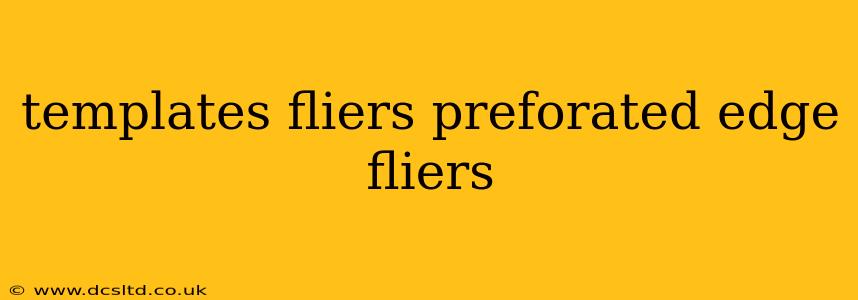Perforated edge flyers offer a unique and effective way to distribute marketing materials. The tear-off sections provide added functionality, whether it's a coupon, a contact card, or a reply slip. This guide will explore the benefits of using perforated edge flyers, delve into available templates, design considerations, and printing tips to ensure your campaign's success.
What are Perforated Edge Flyers?
Perforated edge flyers are printed marketing materials with a line of small perforations along one or more edges. These perforations allow the recipient to easily tear off a section of the flyer, creating a detachable component. This detachable section often contains crucial information like a coupon, a business card, a reply slip, or a small call-to-action. This added feature enhances engagement and encourages immediate response.
Why Use Perforated Edge Flyers?
The advantages of using perforated edge flyers are numerous:
- Increased Engagement: The detachable element encourages interaction and boosts the chances of the recipient taking action.
- Improved Response Rates: Coupons, discount offers, and contact information are more likely to be retained when separated from the main flyer.
- Targeted Information: The tear-off section can contain highly targeted information tailored to a specific audience segment.
- Enhanced Memorability: The unique design makes your flyer stand out from the competition.
- Versatile Applications: Perforated edge flyers are suitable for various industries and marketing campaigns.
Where to Find Perforated Edge Flyer Templates?
While finding pre-made templates specifically labeled "perforated edge" can be challenging on free template websites, many design platforms allow for custom creation. Here's how you can approach it:
- Canva: Canva offers extensive customization options. You can create a flyer and then add a perforated line using the line tool, ensuring the line is precisely placed for easy tearing.
- Adobe InDesign/Photoshop: Professional design software like Adobe InDesign provides even more control over the design and placement of perforation lines. You can create the perforation effect using the line tool and setting the appropriate stroke weight.
- Online Printing Services: Many online printing services like Vistaprint, Moo, and FedEx Office offer design templates that allow for adding custom perforation lines. Check their template options or contact their support for assistance. Remember to specify "perforated edge" in your requirements.
Remember to always check the printing service's guidelines on perforation specifications to ensure a clean tear.
Designing Your Perforated Edge Flyer: Key Considerations
Effective design is crucial for perforated edge flyers. Here are some key points to remember:
- Clear Separation: Ensure the detachable section is clearly distinguished from the main flyer, both visually and through the perforation line.
- Strong Call to Action: The tear-off portion should have a compelling call to action.
- Branding Consistency: Maintain consistent branding throughout the flyer and the detachable section.
- Easy Tear: The perforation line should be designed to facilitate a clean and easy tear without damaging the flyer.
Choosing the Right Paper Stock
The paper stock you choose greatly impacts the success of your perforated edge flyer. Consider:
- Weight: Heavier paper stock gives a more professional feel and prevents easy tearing outside of the perforation lines.
- Finish: A matte or uncoated finish is often preferred for better ink absorption and a more tactile experience.
Printing Tips for Perforated Edge Flyers
- Specify Perforation: Clearly communicate your perforation requirements to your printer. Provide detailed specifications, including the location and type of perforation.
- Test Printing: Always do a test print before a large order to ensure the perforations are correctly positioned and easy to tear.
- File Format: Use the appropriate file format recommended by your printing service. High-resolution images are crucial for a professional finish.
Frequently Asked Questions (FAQ)
How do I create a perforated line in my flyer design?
Most design software (Canva, Adobe InDesign, etc.) allows you to create lines. Use the line tool and adjust the stroke weight to simulate the perforation. The key is precision in placement so the tear is clean. Many online printing services offer perforation as an option during the design/upload process.
What type of paper is best for perforated edge flyers?
Heavier weight paper stocks (e.g., 100lb or higher) are preferable to ensure the flyer doesn't tear easily outside the designated perforation lines. A matte or uncoated finish usually provides a better printing result and tactile feel.
Can I use any design software to create perforated edge flyers?
Yes, most design software allows for the creation of a perforated line. However, if you lack design experience, using a template from an online printing service might be easier.
By carefully planning your design and printing process, perforated edge flyers can significantly enhance your marketing efforts. The added interactivity and unique design make them a valuable tool for increasing engagement and response rates.
